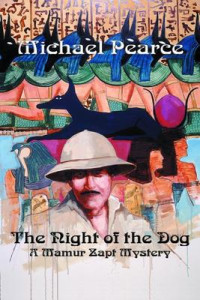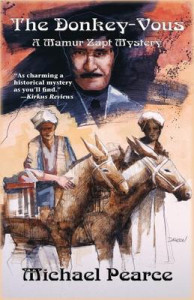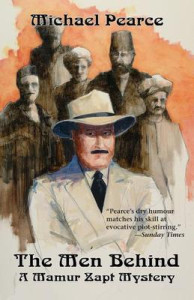The Mamur Zapt & The Return of the Carpet
The Night of the Dog: A Mamur Zapt Mystery
The Donkey-Vous: A Mamur Zapt Mystery
The Men Behind: A Mamur Zapt Mystery
The Girl in the Nile: A Mamur Zapt Mystery
 Although I’ve read and enjoyed quite a few murder mystery series, it’s only recently that I’ve begun making regular visits to the mystery sections of the bookstores I frequent. I discovered The Night of the Dog facing out on an eye-level shelf of the mystery section of our favorite independent bookstore the last time I gave it a browse. My husband, who spends a lot more time in that store than I do, says it’s been there for a while. See what I’ve been missing by not looking in that section!
Although I’ve read and enjoyed quite a few murder mystery series, it’s only recently that I’ve begun making regular visits to the mystery sections of the bookstores I frequent. I discovered The Night of the Dog facing out on an eye-level shelf of the mystery section of our favorite independent bookstore the last time I gave it a browse. My husband, who spends a lot more time in that store than I do, says it’s been there for a while. See what I’ve been missing by not looking in that section!
The other four titles in this review came from various and sundry used book dealers who list their wares online. As you can readily see, they are on two different presses. Poisoned Pen Press, an independent publisher based in Scottsdale, Arizona, is currently the publisher of record for the series. Most of the titles are available in trade paper editions, as are the copies I obtained. The two from Mysterious Press are in hard cover (and feature better cover art, at least to my taste), but this press, which is an imprint of Hachette Book Group USA, didn’t pick up the whole series. If you look hard enough, you can find some, but not all, of the titles on other publishers, as well. I noticed that William Collins Sons & Co., Ltd, which is now part of HarperCollins UK, originally published at least one of the earlier titles. But I digress. . . .
To begin with, the “Mamur Zapts” aren’t exactly murder mysteries – not all of them involve murders or any sort of unexplained death. They are more precisely police procedurals. The series takes place in and around Cairo in the early years of the twentieth century, or about thirty years into the British occupation of Egypt. As author Michael Pearce briefly explains in a note at the start of The Return of the Carpet, the British, concerned about their Suez Canal interests, moved in to  advise the Egyptian government in 1881 after a near-bankruptcy fomented open and violent rebellion. Problem is, by 1908, when the series opens, this not-so-informal rule had gotten very old for the Egyptians, and several nationalist groups had arisen, all causing trouble in different ways.
advise the Egyptian government in 1881 after a near-bankruptcy fomented open and violent rebellion. Problem is, by 1908, when the series opens, this not-so-informal rule had gotten very old for the Egyptians, and several nationalist groups had arisen, all causing trouble in different ways.
The main character of the series is Gareth Cadwallader Owen, a Welshman in his late 20s who bears the rather enigmatic title of the Mamur Zapt, the head of the Secret Police. He’s a Captain in the British Army, assigned to work with the local police department on cases that have a national security angle – a British national security angle, that is. So, for example, The Return of the Carpet concerns a threatened nationalist demonstration at a major Islamic event; Donkey-Vous revolves around the apparent abduction of a French businessman that puts a strain on Anglo-French diplomatic relations; The Night of the Dog focuses on tensions between the Copts (Egyptian Christians) and Moslems; The Men Behind are terrorizing British and Egyptian Civil Servants; in The Girl in the Nile, a woman disappears from a pleasure boat hired by a member of the Egyptian royal family.
Initially stationed in India’s Northwest Frontier, Captain Owen transferred to Egypt about five years before the series begins. He has no family ties and has lived  away from England so long that he literally can’t imagine going back. His facility with languages enabled him to learn Arabic in a relatively short time. He also seems to be extremely comfortable with Arabic culture and quite tolerant of his colleagues, regardless of their ethnicities. Although he has no formal training in criminal investigation procedures, his problem solving skills, patience and sense of humor serve him in good stead.
away from England so long that he literally can’t imagine going back. His facility with languages enabled him to learn Arabic in a relatively short time. He also seems to be extremely comfortable with Arabic culture and quite tolerant of his colleagues, regardless of their ethnicities. Although he has no formal training in criminal investigation procedures, his problem solving skills, patience and sense of humor serve him in good stead.
Captain Owen’s work is greatly complicated by the peculiarities of the British-Egyptian political system, which also still bears the influence of the early nineteenth century French occupation and of the country’s long relationship with the Ottoman Empire. The Khedive, for example, is still the titular ruler of Egypt, although he is in fact a puppet of both the British authorities (who run all the ministries and control the national treasury) and the Turkish Sultan. This Khedive, not named in this series, was Abbas II, a descendent of the great Muhammad Ali Pasha.
Owen is accountable both to the Sirdar, the British commander-in-chief of the Egyptian Army, and to the civilian Consul-General (otherwise known as the British Agent or colloquially the Old Man). Owen works for the police department, which is organizationally located in the Ministry of the Interior. He has to liaison with the Ministry of Justice, known as the Parquet, which is responsible for investigation and prosecution of crimes.
Owen’s position as the Mamur Zapt gives him considerable authority, both actual (such as the right to search premises without a warrant) and symbolic (many people simply roll over for him once they learn his title). Nonetheless, he is not expected to bring criminals to justice. In fact, in The Return of the Carpet, his  supervisor admonishes him to concentrate instead on preventing trouble before it starts. The same supervisor further recommends that Owen’s best strategy is to create a map of Cairo, and it’s evident that he means both a map of the physical layout of the city (quite enough of a challenge) and a comparable map of his informant network. Although the title “Mamur Zapt” appears to be a Michael Pearce invention, the role was well-established in Cairo (I encountered evidence of it in books by Gamal al-Ghitani and Naguib Mahfouz), and Owen has actually “inherited” a vast network of spies and agents from his predecessors.
supervisor admonishes him to concentrate instead on preventing trouble before it starts. The same supervisor further recommends that Owen’s best strategy is to create a map of Cairo, and it’s evident that he means both a map of the physical layout of the city (quite enough of a challenge) and a comparable map of his informant network. Although the title “Mamur Zapt” appears to be a Michael Pearce invention, the role was well-established in Cairo (I encountered evidence of it in books by Gamal al-Ghitani and Naguib Mahfouz), and Owen has actually “inherited” a vast network of spies and agents from his predecessors.
Several secondary characters appear across all or most of these novels. In fact, there are so many of these that I’ve found it necessary to keep a crib sheet near me when I read the series so I remember who’s who. Admittedly, some of them are far more memorable than others. Among those is Owen’s lover, Zeinab, daughter of an old Egyptian politico and a famous Turkish courtesan, a very independent woman with a preference for French culture. His closest colleague in the Parquet, Mahmoud el Zaki, is a native Egyptian (and Egyptian nationalist) who studied criminal justice and law at university. I’ve already mentioned Owen’s immediate supervisor Garvin, the commandant of the Cairo police department. He is an experienced law enforcement professional who has been in country long enough to know both the language and the culture well. In Donkey-Vous, he demonstrates this understanding in his skilled interview of several witnesses to an event, a process Pearce aptly describes as “circumlocutory.”
Some of the other secondary characters are less well drawn and therefore considerably more challenging to recall. McPhee, the assistant commandant, is a former school teacher. Owen works closely with his secretary Nikos the Copt and his agent Georgiades the Greek. They share with him an orderly named Yussuf, who brings the coffee and often provides comic relief. Owen is also friendly with  Paul, who works directly for the Consul-General and John, who works for the Sirdar. The Consul-General and the Sirdar, like the Khedive, make very rare direct appearances in these books, although the other characters refer to them often when invoking the various forms of conflicting authority that challenge their investigation process.
Paul, who works directly for the Consul-General and John, who works for the Sirdar. The Consul-General and the Sirdar, like the Khedive, make very rare direct appearances in these books, although the other characters refer to them often when invoking the various forms of conflicting authority that challenge their investigation process.
I’ve read Naguib Mahfouz’s magisterial The Cairo Trilogy, as well as numerous other pieces of fiction and non-fiction about Cairo by Arabic, Anglo and French writers. I’ve also spent time poring over paintings of the city’s gates, marketplaces, and mosques, rendered by the Western artists who frequented Cairo during the British occupation. I think I have a pretty good sense of what Cairo was like in those days. Pearce does a splendid job of portraying the city; so much so, in fact, that I am strongly tempted to compare his writing in this regard to that of the aforementioned Mahfouz, or perhaps more directly (since Pearce is not a native Egyptian) to Balzac’s writing about Paris or Dickens’s about London. In all these instances, the city is so thoughtfully and meticulously portrayed as to become literally a “character” in the stories.
As I read these books, I am continually delighted by Pearce’s brief but evocative descriptions of streets, houses (of the very wealthy and the very poor), nightclubs, brothels and gambling establishments, offices, hotels and hammams (public baths). He also manages to capture the city’s distinctive cultural practices, such as the hot afternoons when most people retreat to the coolest, darkest parts of their houses to sleep, to the ubiquitous donkeys, camels, and horse-drawn arabeahs (carriages) that clog the narrow, dusty streets. About the only cultural practices that receive inexplicably short shrift are those related to the practice of Islam. I am more than a little surprised by this obvious oversight – it would have been terribly easy to make occasional reference to the muezzin’s call, Friday services, or events taking place just before or after a particular prayer time.
Nonetheless, Pearce deserves credit for his descriptive prowess. Let me give you an example from The Return of the Carpet (page 67 in the Poisoned Pen Press version):
Everywhere, even in out in the middle of the thoroughfare, were street-stalls: stalls for nougat, for Turkish delight, for Arab sugar, for small cucumbers and oranges, for spectacles, leather boots and slippers, for cheap turquoises, for roses, for carnations, for Sudanese beads made in England, for sandalwood workboxes and Smyrna figs, for tea, for coffee, for the chestnuts being roasted around the foot of the trees.
And everywhere, too, were people. The women, in the shapeless dark gowns and black veils, were going home. But the men were appearing in all their finery to stroll around the streets and sit in the cafes. Here and there were desert Arabs in beautiful robes of spotless white and black, and a rather larger number of blue-gowned country Arabs from Der el Bahari. But for the most part the men were dressed in European style, apart from their handsome tarbooshes. All, however, had magnificent boots, which the shoe-brown boys fought to shine whenever an owner sat down in a café.
I would say that Pearce is stronger on setting than he is on historical detail. The first sentence of The Return of the Carpet establishes that the story starts in 1908, but Pearce seldom refers to dates thereafter, and his use of history is general, rather than specific. Incidents involving demonstrations by Egyptian nationalist groups occurred regularly during this time, but Pearce makes no apparent effort to link his stories to any particular incidents. The Donkey-Vous refers in passing to contract negotiations around an Aswan Dam construction project for which the Scottish engineering firm John Aird and Company was the primary contractor – this much is historically accurate.
Each of the books in the series is relatively short, generally in the range of 250 pages, which is not uncommon for procedurals of this sort. They read fast, in part because Pearce tends to favor dialogue over exposition. The piece I’ve quoted for you is typical of his expository style (again reminiscent, for me, of Balzac or Dickens). Most of the rest of the expository narrative describes action – short, straightforward sentences with verbs prominently placed.
Pearce also avoids spending a lot of narrative time on the characters themselves. Physical descriptions are sketchy at best. I can tell you, for example, that Owen has relatively dark skin and often wears the native tarboosh (fez), and that Zeinab has a strong, beaky face and dark hair, that Mahmoud is a sharp dresser and Georgiades is a bit plump. That’s about it. I can tell you even less about the backgrounds and motivations of the characters. These are definitely not introspective or ideological novels!
Pearce also tends to eschew any narrative approach that would provide continuity from one story to the next. I read The Night of the Dog out of sequence, simply because it was the first book in the series that I encountered. I was nearly halfway into the story before I figured out that Zeinab was Owen’s lady friend and not a member of the police department, and just a few pages from the end before I had enough information to determine that they were lovers! I was just about halfway through this book before I got the clue that Owen spoke Arabic, and I couldn’t entirely resolve the roles of Nikos or Georgiades until I started the series from the beginning. Past Return of the Carpet, none of the novels feature a forward, and most start quite abruptly (my favorite is Donkey-Vous, which opens with the terribly enigmatic sentence “Owen arrived at the hotel shortly afterward.”) What I am suggesting is that this is probably not a series you can easily “pick up” in the middle.
At present, there are fifteen titles in this series. I figured that reading the first five would give me (and you) a good idea what they were about. Since I started reading them, I have looked in vain at the mystery section of every bookstore I’ve visited in search of more titles. Alas, this doesn’t seem to be a series that most bookstores stock. You can, if you are so inclined, obtain a complete set of the entire series in trade paper directly from Poisoned Pen Press. Most of the titles also appear to be available from the usual online sources, although I noticed that many of these are ex-library books, which I don’t personally like to buy. I cringe at the thought of reading so many books by the same author, but eventually I am going to have to give in. They are quite addictive!
Born in 1933, Michael Pearce grew up in what was then known as the Anglo-Egyptian Sudan and returned there as a young adult to teach. According to the brief bio-sketch that appears in the back of some of the books, he spent time during his career writing, editing, and engaged in academic administration, which he considers far more savage than international politics. As a hybrid middle manager and teacher at a public university in a rural U.S. state, I have a good idea what he means by that! I can only guess that he started writing these novels as a diversion as he transitioned into retirement. I wish him a long and productive life!
(Poisoned Pen Press, 1988)
(Poisoned Pen Press, 1989)
(Mysterious Press, 1990)
(Mysterious Press, 1991)
(Poisoned Pen Press, 1992)
[Update: Michael Pearce died in 2022, having completed 19 Mamur Zapt novels and at least one short story in the series, plus other procedurals.]
